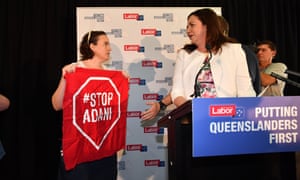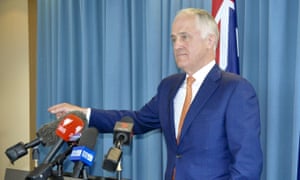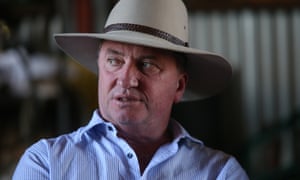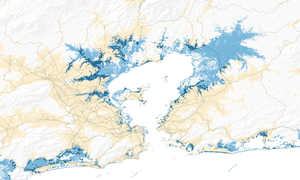The Adani Group’s proposed mine-rail-port development linking a massive new coalmine at the Carmichael site in the Galilee basin to an expanded port at Abbot Point near Bowen was always going to be an electoral negative for the Palaszczuk Labor government.
One the one hand, Labor’s Liberal National party and One Nation opponents are enthusiastic backers of the Adani project, and will use this fact to campaign in marginal seats in Townsville and Rockhampton. On the other hand, the Greens, backed by the majority of the Australian public, are strongly opposed. The Adani issue could well cost Labor the inner-city seat of deputy premier Jackie Trad, and possibly others.
Lined up behind the Greens is all the environmental and economic evidence that the project should be abandoned. The mine, if it went ahead, would represent a disastrous increase in the global supply of coal. And, since it can only proceed with massive financial support from Australian governments, it will be an economic disaster as well.
For a long time, the Palaszczuk government managed a delicate balancing act, rejecting LNP proposals to tip public money into the project, and avoiding overly enthusiastic support, while doing nothing that would lead to their taking the blame when the project fell over, as remains the most likely outcome. However, such a balancing act could only be sustained for so long.
In June, the Queensland Labor government finally came down on Adani’s side, negotiating a royalty holiday and other concessions. Premier Annastacia Palaszczuk flew to Townsville for an official opening of Adani’s regional headquarters, which promised to welcome about 500 employees “in coming months”. As usual with Adani, the promise was not kept. Nearly six months later, there have been hardly any new hires and the regional headquarters now promises only 150 jobs.
Of course, the big number that swayed the government was the promise of 10,000 jobs, regularly discredited and just as regularly repeated. Adani’s own expert admitted that the modelling behind the claim was spurious and the true figure was closer to 1,500, but that hasn’t stopped the spruikers.
More importantly, these claims ignore the fact that the public money needed to get Adani started could be used to create more, and more socially productive jobs than those generated by a fly-in-fly-out (Fifo) mine and a largely automated railway. As I showed in work for Farmers for Climate Action, the agricultural sector alone could generate more jobs than the Adani project.
The case that Adani will cost rather than create jobs has been confirmed, in spectacular fashion, by none other than Townsville mayor Jenny Hill, the project’s most enthusiastic backer. To secure a promise from Adani that half of the Fifo workforce will be based in Townsville, Townsville City Council agreed to pay half the cost of building an airstrip at the mine site, more than 600km outside the council’s jurisdiction.
Under the deal, the airstrip will be used, free of charge, by Adani, but any subsequent mines will have to pay. The estimated cost to the city is $18.5m. Rockhampton, which had been in the running to secure the whole base, had no alternative but to match Townsville’s offer.
This would be a misuse of public money under any circumstances but what has just come to light is the truly appalling fact that the money given to Adani has been saved by Townsville council by cutting over 100 jobs. The process is euphemistically described as “belt-tightening”, but of course the consultants and senior managers who pushed the process through won’t be tightening their own belts. They never do.
The most likely outcome of all this is an anti-climax. Having been turned down by all the major Australian banks, and nearly all the major global banks, not to mention the State Bank of India, Adani has to rely on the generosity of the Turnbull government’s Northern Australia Infrastructure Facility to get started. But the $900m it is seeking won’t be nearly enough, so approaches are being made to China’s state-owned banks. While the lending decisions of these banks reflect a mixture of politics and economics, it’s hard to see why they would throw away their money on a project with such lousy finances and no obvious strategic benefit.
Unfortunately for the Palaszcsuk government, the final announcement won’t be made until March 2018. When the project was officially launched in June, financial closure was promised for December this year, which would have resolved the issue before the due date for an election. But it’s always a mistake to rely on Adani promises, and the financial close date was extended just far enough to make this impossible.
As a result, Palaszczuk faces an election campaign where she will be dogged by anti-Adani protesters on the one hand and doubts about her enthusiasm for the project on the other. The LNP faces no such problems. But should they win, their difficulties will start when the project falls over, as it almost certainly will.








View all comments >
comments (633)
Sign in or create your Guardian account to join the discussion.
Hopefully it'll haunt every campaign till it's dead and buried
It's not just Queenslands problem
It's Australia's and the worlds
damn straight. I'd vote a full aboriginal Government in if it meant saving this big brown country from going from a shining opal to one big turd of brown land they are hell-bent on turning it into.
To be honest, I'd vote in an all aboriginal parliament anyway. The current mob on all sides couldn't run a chook raffle.
I would much rather a group of people looking to run the country rather than their own SMSFs.
But it is a problem created by the voters of Queensland...
who seem to have thrown a lot of weight behind One Nation the climate change deniers..
along with the Libs and Nats.. also deniers of the science.
How to deal with the Queensland (regional) voter..
Labor stay on course... Greens oppose .. capture those votes for and against..
Form government...and find compromise.
Alternatively Oppose outright ..and hope Queenslanders have come to their senses. And don't forget.. they opposed daylight saving for years, fading curtains etc.... and only recently voted in ...
..what was that idiot's name again.
If Palaszczuk goes ahead with supporting adani she will loose my vote. This is to big to play the lnp/labor game.
What, she hasn't lost your vote already?
She has done nothing other than support Adani, and, in the background, Gina and Co's five other planned mega coal mines to follow and add to Adani's devastating mine infrastructure in the Galilee Basin.
Easy solution. Vote Green.
I agree Azit. I am coming to the opinion that Adani is a smokescreen, deflection, red-herring and any other phrase you care to name, for Gina's mines that together will be larger than Adani ever will be. The train line isn't for Adani, it's for Her.
We need to incorporate Gina into the #StopAdani campaign.
Quite true but the Libs don't have a better response, they are worse
Have principle.Vote for neither
That's true. Which is why you should vote Green.
Not a problem I'm an outside observer
Lest the race card is played in comments on this story we need to state unequivocally that if Adani want Indian but American or British or Swedish or Chinese or Japanese or Korean the evidence would say the same thing:
This coal mine - and others in the Galilee Basin - is economically unsound, environmentally damaging and morally indefiensible
Investment such as that of Mr Gupta in the Arrium steel mill in SA is welcomed as it's economically sound, environmentally sensitive and morally laudable.
Well said. A story of misconception, misdirection and greed.
This is not a deal for the betterment of Australians or QLDers in particular. It is an accounting entry for the morally corrupt owners of Adani.
Yes, the coal mine is economically unsound; if Gautam A. has any sense, he'll pocket Turnbull's generous donation, get a railway built on the lands confiscated by the Palaszczuk government and go into the water mining business. 60 years of free unlimited licence in the middle of a drought in the driest inhabited continent has to be worth a fortune!
Hi HS
As always from you, a great post!!!!!!
Made me think back to the final bits of "the big short"
Thanks
I've been around a while, and I can't remember any government decision that has riled me more than to approve and support this massive new coal mine. Endangering the reef, endangering farming lands through water tables, taking a huge step backwards regarding climate change, and squandering a billion taxpayer dollars. Yet governments of both sides are supporting it. I'm utterly ashamed to be Australian.
Not quite the true history. Early on the Palaszczuk government spent many $million on new capital works at Abbott Point to move the tug boat base there to a new site to make way for Adani's planned second coal loading facility.
Queensland made itself more vulnerable to politics before policy, when it eradicated the upper house. Queenslanders are no less one-issue voters than the rest of Australia, and like the rest of Australia, we will suffer the consequences of our irresponsibility.
ANY Queensland government in the near future, will be either far right ("LNP"/PHON) or near right (Labour / whoever); a vote for the far right is a garauntee of Carmichael, where as a vote for the near right still holds a germ of a possibility that Carmichael might founder...
Adani is a big one. But the fact her government has done absolutely nothing of substance since being elected is another.
That's true, but sometimes doing nothing can be a good thing. If only the Newman government had done absolutely nothing of substance then Queensland would be in a much better place at the moment.
Anything in particular he did you didn't agree with?
Do you mean in addition to offering hundreds of millions of taxpayers dollars to Adani and other mining companies to build catastrophic coal mines that will help drive global warming?
https://www.thesaturdaypaper.com.au/news/politics/2014/11/22/newman-government-courts-adani-galilee-basin-coal-deal/14165748001280?cb=1509504845
Not saying it is right, but it is a political survival decision - you can have the LNP and the coal mine and it's conditions, or ALP and the coal mine and its conditions.
Political survival was Beattie's "just vote 1" ploy. Anna 2 is a loser, except that she'll assuredly get a comfy job post politics for services rendered
If yhey cant come up with better policy than this then they are pathetic.
Or we can stop the coal mine altogether.....
Dig a great big hole and take it all away. Who gets the "lions share" of the money, not us - overseas company. Once they go the "big hole" will need to be "rehabilitated". Anyone else have a problem with this?! I want jobs for Australians, long term ethical jobs. Well jobs that don't include destroying our country for short term gain. Once its gone its gone and we can be left with a pile of rubbish that was once our beautiful country. The first people of Australia have looked after this beautiful country for millions of years, only taken us 200 to be well on the way to stuffing the place right up and giving it all away to people who seek money from this venture quite directly.
My beautiful Great Barrier Reef lies in serious decline and the colours that once were seen are no longer there. Bloody disgrace - what will they say when it truly is TOO late. Are they all dwarves from Ben and Holly's Little Kingdom, they dig, that's what they do they say. - seems the Governments of past and present are quite probably dwarves and they care stuff all for those of us living above on the earth.
Labor's Adani strategy is the worst thing they could do and, because they're stupidly calling an early election, there is nothing to be done about itl. Their vaguely supportive stance pleases nobody and will likely lead to another hung term for someone - like many others, I no longer care which Party mismanages Queensland any more. The infuriating thing is that I think, underneath, Labor is sound on Adani - they don't want the Carmichael Mine. But, they have decided to be clever and play politics with it. That is a game that can end up with a lot of people getting hurt, unless you are extremely clever and scrupulously honest. Unfortunately, Labor seems to be neither of those things. Yes, I know the LNP is much worse, but Labor has a duty to pursue what it really believes in and to stick to it - it has to be much better than the LNP, not dip into the same filthy trough.
I am a supporter of genuine Labor, but the desperate Palaszczuk is not! ...
... she is misusing the name Labor and is simply a greedy, narcissistic egomaniac.
So would you prefer One Nation and the LNP? That's what you'll get if not Labor that will be at least tempered by the Greens.
If the first two get into power they'll not only back Adani's mine even further and throw him money, but you'll probably see every trees in QLD get chopped own for land clearing, and you'll be able to kiss goodbye to the GBR for absolute certain.
Vote Greens 1 and Labor 2. Put the L/NP and One Neuron last. That way you show your displeasure with Labor's Adani policies but you don't elect the L/NP/ON destroyers.
Please are you saying You are the Epitome of Genuine Labor.
Ques on what basis have you arrived at your egotistical statement.
Have you ever been a member of the Party ????
For your Info I have been an active member of Labor for over 40 years and have heard people claim to be Labor voters even when the primary vote has crashed.
Excerpt from a letter I received from Premier Palasczuk:
"The Queensland Government is meeting its election commitments not to subsidise the Carmichael coal mine or rail project with taxpayers’ money, to protect the Caley Valley wetlands and stop the disposal of dredge spoil offshore at sea in the Great Barrier Reef World Heritage Area.
The previous Government was going to use taxpayers’ money to directly subsidise the rail line for the Adani Carmichael coal project and allow for dredge spoil to be disposed of offshore at sea in the Great Barrier Reef World Heritage Area near Abbot Point. (This is still LNP and One Nation policy)
Under the Palaszczuk Government’s resources framework the Adani Carmichael mine will pay every cent of royalties in full and there will be no royalty holiday. The Premier has secured agreement that Adani’s project workforce will be sourced from regional Queensland and will not use 457 workers. The Palaszczuk Government has delivered on the election commitment to provide a solution for the Abbot Point coal terminal through a world-leading framework to ban offshore dumping of dredge spoil in the Great Barrier Reef World Heritage Area. The Carmichael project must comply with stringent approval conditions that ensure it will not pose an unacceptable risk, with almost 270 conditions placed on the project to protect the environment, landholders, Traditional Owners and water users."
The final paragraph is subject to the mine actually starting, if it ever does. Abbot Point is facing a $1.6 billion dollar refinance, and the rail line will not be built without the Turnbull Government and NAIF.
My concern is that the real story is just not getting out there, and Palasczuk's government will not be re-elected because of fake news and propaganda by the right wing wingnuts like Canavan, Hanson and co.
The real news is that Adani will go ahead under ALP. NOT GOOD ENOUGH BY HALF.
Oh sure, and just this morning she was saying that Adani was paying for the 60 year grant of artesian water she actually gave them free! And that it wouldn't hurt the artesian basin one bit! She said those were facts too!!
Thanks - this isn't widely known throughout Australia esp the SE of Qld when the Courier mail is the dominant (only?) newspaper in Brisbane.
Sure. But one big problem. The only party promising to reverse it are the Greens. They won't win ANY seats in parliament.
So who do you vote for?
You think the LNP is going to fix it?
What about One Notion?
At least the ALP is enforcing some restrictions on dumping soil and protecting wetlands.
You get rid of the ALP then it will be complete open slather.
I don't like Adani either but I fear an LNP-One Notion Govt more.
To hell with opportunistic strategies. Vote with principle. Back your beliefs not parties. Dont sell your soul like Annastacia. Vote.....Green
Sure. But you will get an LNP -One Notion COALition.
That is just a fact.
In fact it is the most likely outcome of this election anyway.
In 91 of 93 electorates the Greens have no chance of being ahead on first preferences, which means that preferences will flow to elect a pro Big Coal, pro Adani Lab/LNP/Phon/Kat/Independent candidate.
So most voters can't actually give the Greens a valid vote without also giving Adani support due to Anna 2's clever change to compulsory exhausted preferences.
In most electorates cast an invalid/protest vote.
Probably just voting "1" for the local Greens candidate with the remainder left blank is the way to go. That would certainly make the message clear to Labor at all political levels.
Unlike some ill informed Townsville and Rockhampton residents, most North Queenslanders can see straight through Adani. ALP voters in the north are anxious.The 2 or 3 seats which Labor wins because of this sham deal will be lost elsewhere.
How can the ALP Qld be SO STUPID?
Hey, they're Queenslanders.
After careful consideration... he's prob right.
The ALP needs to get off the fence
Will you then vote for them?
And cnog needs to stop being an egg.
Appropriate! Jo brought the term in usage, appropriately. Jo would be totally in favour of anything that turned a buck.
It was interesting listening to Mean Mister Mustard on Monday night's Q&A.
For once I can agree with him.
That's Colonel, to you.
Sorry, Sir...... Click, Click
I don't know whether the press are only telling one picture, but if activists are only targeting Labor, then they should stop it and target One Nation and the QLD LNP equally as well, since they will care far less about environmental degradation and CO2 emissions.
If they help One Nation and the LNP get into power out of protest, then that is called shooting yourself in the foot.
Quick frankly I think Adani's mine as damned anyway.
And if you help the ALP you are shooting your foot. Vote for neither.
It's a question of the lesser of two evils. Personally I'd vote for the Greens.
In reality The Greens cannot attain government in their own right in QLD this election. The result will be either Labor or LNP and/or One Nation. At least if Labor gets in there is a chance that the Greens can have an influence on Labor. I really don't think the climate sceptics in either of the other two parties will be better in the least, it will just be rape and pillage of the environment.
Better get used to it Anna because every day of the election you will have ADANI hanging around your neck...
If you had one iota of common sense ADANI would be toast.
The arguments.
1.This is a foreign multi national who has both an appalling environmental record ,and is being investigated for corruption, and financial fraud in India.
2. The corporate structure of Adani will allow profits to be shifted to a tax haven.
Up to $3 billion from Adani's planned Carmichael coal mine will be shifted to a subsidiary owned in the Cayman Islands if the controversial project goes ahead, an analysis of company filings shows.Key points:
'Royalty deed' gives shell company rights to recieve $2-a-tonne payment beyond first 400K tonnes mined for two decades
Entitlement owned by company registered in Cayman Islands, controlled by Adani family
Carmichael coal mine's production capacity means payment ammounts to about $120 million per year
An "overarching royalty deed" gives a shell company rights to receive a $2-a-tonne payment, rising yearly by the inflation rate, beyond the first 400,000 tonnes mined in each production year for two decades.
The company with this entitlement is ultimately owned by Atulya Resources Limited, a secretive entity registered in the Cayman Islands, and controlled by the Adani family.
3.The supposed 10,000 jobs is an outright lie and was shown as such when Adani's own research showed it would be 1464.
The 1,464 number comes from Adani’s expert witness in the Land Court, Jerome Fahrer from ACIL Allen consulting.
4.Rather than waste a billion dollars on a railroad to nowhere the money would be far better spent on massive solar farms, pumped hydro and wind projects in the Far North QLD.
As numerous studies have shown in the United States a million dollars invested in renewables generates 15 jobs, the same amount in fossil fuels just 5 jobs.
5.A further increase in CO2 emmissions that will be generated by the Adani mine have potential to destroy the Great Barrier Reef.
As the largest coal mine in the Australia when completed, Adani will legitimise the idea of mining all of the coal in the Galilee Basin. If extracted and burnt, this will get the world one-third of the way toward 2℃ of global warming.
The Adani mine alone will see up to 2.3 billion tonnes of coal extracted from an area five times the size of Sydney Harbour over 60 years. This is equivalent to putting out 7.7 billion tonnes of greenhouse gases. The global budget is now less than 500 billion tonnes in order to have an 80% chance of keeping global average temperature rise to less than 2℃.
6. Tourism directly and indirectly employs 220,000 Queenslanders - or 9.4% of all people employed in Queensland. Tourism contributes $11.2 billion directly to the Queensland economy.
Jobs losses from this sector due to runaway climate change ,would cripple the FNQ economy.
7, Billions of litres of water drained from The Great Artesian Basin "It's bloody-minded and barbaric," said Bruce Currie, a grazier who lives in the region and has joined legal action against Galilee mines. "This is going to definitely impact on the integrity of the Great Artesian Basin."
According to a supplementary environmental impact statement, the mine will draw 26 million litres of water a day from its pits by 2029 as it ramps out annual production to as much as 60 million tonnes.
The effect on farmers and rural communities, who rely on this water will be devastating.
The Labor support for Adani makes absolutely no sense .
View discussion
I would vote for you wedloik! Anyday!
Anyone else notice the Vote Liberal flyer in the back pocket of that Adani protester ??
Be careful Queensland, be VERY, VERY CAREFUL !!
Gee Blue I hope you are aware that the main Lobbyist for Adani is one Cameron Milner.
Guess where good old Cameron works?
Give Up?
Labor Queensland HQ, also this jerk was former Chief of Staff to Bill Shorten.
How did the Queensland government become embroled in this Adan thing whch sees this company with copious amounts of air tme and throwing their weight around. Has the government lost ther minds as it seems that Adani now calls the shots. Australians where are you?
Where the money is bud!
The unemployed ones are hoping to get jobs at Adani. They have heard that the industry super funds are also hoping for big returns from Adani.
Queensland has a choice then, boot the main parties out, try hard not be racist isolationists, vote Green and force Adani off their state.
Never going to happen.
Bever say never
The "n" is right beside the "b". Bugger isn't it?
i'm wondering when get up will be campaigning against the mine in labor held seat such as palaszcsuk and trad.
They will be, to answer your cynical question. As I understand GetUp will be campaigning against any members regardless of party who actively support the Adani mine. Presumably that will include Annastacia P., although her seat is so safe its not going to make much difference.
I understand that they'll be campaigning in the inner Brisbane seats that are marginal for Labor as the Greens do not support the mine.
Get-Up use their scarce resources in the manner most likely to have the greatest positive effect. You might say they are ultra-efficient, you would think that the LNP and the Australian would be holding them up as a model for how organisations should be run (except the LNP and the Australian don't really care about efficiency, they care about lining their own pockets with gold).
Actually the Liberals have tried to emulate Get-Up's efficiency, but its a laughable effort. Liberals just don't get efficiency. Look at Bronwyn Bishop flying helicoptors...
Ha ha.
As of yesterday an email addy I've only used for GetUp is being spammed from info@queenslandlabor.org
Getup no doubt has passed my details on to them via ACTU affiliated donors as they do for everyone of their contacts. In return GetUp gets access to union and the huge Labor Party privacy law exempt database they keep on everyone.
Don't think those calls you'll be receiving from GetUp are cold calls - they already know you.
Meanwhile, China's demand for coal continues to slide. China consumes 50% of the world's coal. This decline in coal use is driven by (a) horrendous air pollution; (b) the cheapness of wind and solar; (c) the desire by the Chinese state to dominate the new growing renewables industries; and (d) the vulnerability of China to global warming and sea level rise. In short, this trend to replace coal by renewables (and gas) won't change. Global coal demand will continue to slide. It would be more sensible of Labor (federal and Qld) to point this out and to put themselves on the right side of history.
Not when there is a buck in going warming... Could it be that Labor is "conflicted"? Bill must really wonder when he looks at Palace-chook and says, "If Anna and my roles were swapped, I'd be doing exactly the same. I'd go the weak way too."
When I was at uni I learned about utilitarianism: the greatest good to the greatest number of people. This is the exact opposite: the greatest good to the least number of people: adani, politicians and the minuscule number of beneficiaries in FNQ. All the weaknesses of our democratic process laid bare right here. Our pollies are nothing more than visionless puppets of corporate greed and moral corruption. They pretend to represent our interests (by "our" I mean the nation's interests) but the do not. Look at Gordon bloody Brown saying GFC banking executives should have gone to jail. What greater admission from a man in charge at the time that the system is in catastrophic breakdown.
It's the devil and the deep blue sea for Queensland...
Let's put all practical matters into consideration, under the LNP it always ends in tears.
Always...
The Adani issue is in the hands of the federal coalition which as everybody knows is going to hell in a... well let's just say they're going to hell, so choose wisely Queensland or you could be run by a cartel of Duttons Joyces and Hansons and it's only going to end in tears.
and you can blame.Palace Chook for selling her soul to get the votes of a few but loosing just as many who have principles
Sign in or create your Guardian account to recommend a comment